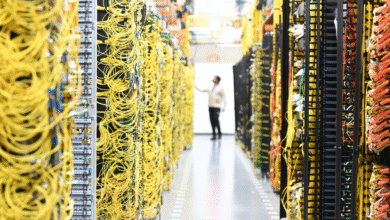Oracle-OpenAI Deal: Why Wall Street Didn’t See It Coming

▼ Summary
– OpenAI and Oracle announced a surprise $300 billion, five-year agreement that highlights Oracle’s significant role in AI infrastructure despite its legacy status.
– The deal reveals OpenAI’s substantial compute appetite and infrastructure diversification strategy, though questions remain about power sourcing and payment.
– OpenAI has committed to spending around $60 billion annually on Oracle compute and $10 billion on custom AI chips with Broadcom, despite burning through cash yearly.
– Power sourcing for large-scale compute remains a critical challenge, with data centers projected to consume 14% of U.S. electricity by 2040.
– OpenAI may adopt an asset-light approach by relying on Oracle’s infrastructure expertise, aligning with its software-centric valuation and avoiding costly physical investments.
This week’s announcement of a $300 billion five-year agreement between OpenAI and Oracle sent shockwaves through the market, driving Oracle’s stock to new heights. While the sheer scale of the partnership caught many off guard, it underscores a critical reality: despite perceptions of Oracle as a legacy player, the firm remains a formidable force in global AI infrastructure. The deal signals not just growth for Oracle, but a strategic masterstroke for OpenAI as it aggressively expands its computational capabilities.
For OpenAI, the arrangement reveals far more than its sparse public details might imply. The company’s readiness to commit such enormous sums to secure computing power offers a clear gauge of its ambition. Still, major questions linger, particularly around where the electricity required to fuel this level of processing will come from, and how OpenAI plans to cover these staggering costs.
According to Chirag Dekate, a vice president at Gartner, the partnership makes strategic sense for both entities. He points out that collaborating with multiple infrastructure providers allows OpenAI to diversify risk and gain a scaling edge over rivals. Dekate emphasized that OpenAI is assembling one of the most comprehensive global AI supercomputing foundations ever seen, describing the move as “exemplary of what a model ecosystem should look like.”
Some industry analysts expressed surprise that Oracle landed such a high-profile AI deal, given the dominance of cloud giants like Google, Microsoft Azure, and AWS. But Dekate argues this underestimates Oracle’s proven capacity to support hyperscale operations, noting its existing infrastructure role for TikTok’s massive U.S. operations. Over decades, Oracle has developed core infrastructure capabilities that deliver extreme scale and performance, a fact sometimes overlooked amid flashier competitors.
Even as investors cheer the news, fundamental issues around power and financing remain unresolved. OpenAI has announced a series of expensive infrastructure moves over the past year, including a $60 billion annual compute commitment to Oracle and a $10 billion custom AI chip development effort with Broadcom. The company also reported hitting $10 billion in annual recurring revenue this June, up sharply from $5.5 billion the previous year. Yet it continues to burn through cash at a breathtaking rate.
The energy required to support this expansion presents another layer of complexity. Data centers are projected to consume 14% of all U.S. electricity by 2040, and tech firms are scrambling to secure long-term power solutions through investments in solar, nuclear, and natural gas. While OpenAI CEO Sam Altman has personally backed energy startups like Oklo, Helion, and Exowatt, OpenAI itself has been quieter than peers like Google or Amazon in making direct energy investments.
That may soon change. With a compute deal of this magnitude, reportedly reaching 4.5 gigawatts, OpenAI will need to address its energy footprint head-on. One likely path is leaning on Oracle’s extensive experience in physical infrastructure, allowing OpenAI to remain “asset light” and focused on software, which aligns with its investor-friendly valuation model. This indirect approach mirrors Altman’s personal investment strategy, positioning the company to scale without the heavy capital burdens typical of legacy tech firms.
(Source: TechCrunch)





